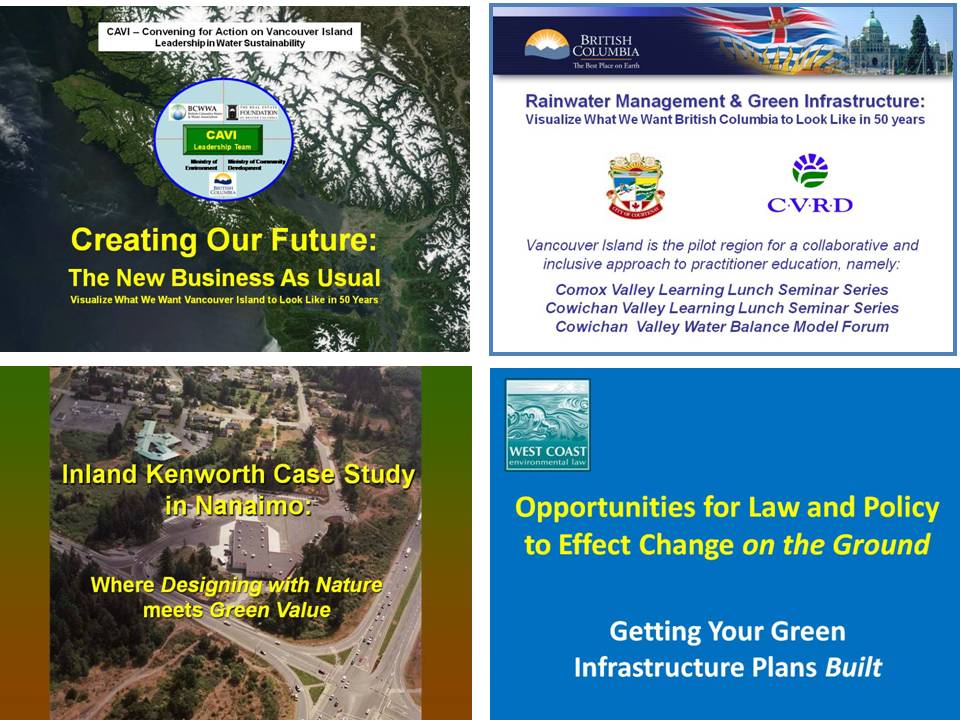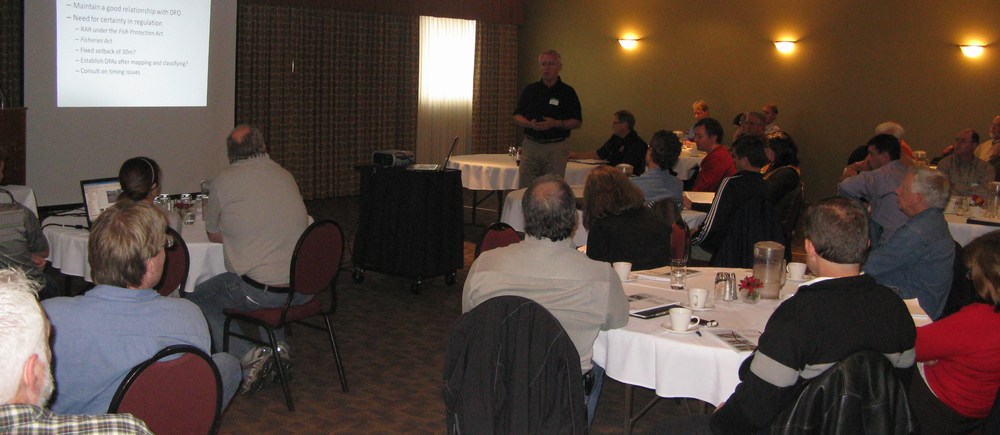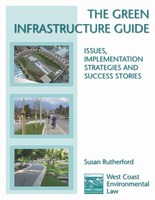Getting Your Green Infrastructure Plans Built: Opportunities for Law and Policy to Effect Changes on the Ground
Note to Reader:
The precedent-setting Vancouver Island Learning Lunch Seminar Series was part of the implementation program for Beyond the Guidebook: The New Business As Usual, This provincial initiative built on the foundation provided by Stormwater Planning: A Guidebook for British Columbia, published in 2002. In 2008, participating Vancouver Island local governments represented some 250,000 people.
- The Cowichan Valley series was hosted by the Cowichan Valley Regional District and comprised a set of three sessions during the June – July 2008 period. To learn more, visit https://waterbucket.ca/viw/category/convening-for-action-in-2008/2008-cowichan-valley-learning-lunch-seminar-series/
- The Comox Valley series was hosted by the City of Courtenay and comprised a set of three sessions during the September – November 2008 period. To learn more, visit https://waterbucket.ca/viw/category/convening-for-action-in-2008/2008-comox-valley-learning-lunch-seminar-series/
The Learning Lunch Seminar Series promoted a consistent provincial approach to rainwater management and green infrastructure. It also added depth to Living Water Smart, the Province’s plan for doing business differently – by encouraging water and land managers and users to make green choices that create liveable communities and protect stream health.


Legal Policies and Strategies to Support Green Infrastructure
Seminar #2 was structured in two parts to facilitate the sharing of experience and lessons learned. The focus was on implementation tools, in particular legal and policy strategies. The two parts were:
- Establishing expectations – this is what we want to achieve.
- Delivering on expectations – this is how we will get there.
The Learning Lunch curriculum was designed to help local governments determine how they would achieve this over-arching goal statement in Living Water Smart, BC’s Water Plan:
- By 2012, all land and water managers will know what makes a stream healthy, and therefore be able to help land and water users factor in new approaches to securing stream health and the full range of stream benefits (page 43, Living Water Smart)
At the second in the 2008 Comox Valley Learning Lunch Seminar Series, held in October 2008, Susan Rutherford of West Coast Environmental Law employed an Issue / Question format to illustrate opportunities and scales for law and policy to effect change. This format enabled a seamless transition into a town hall discussion where seminar participants talked about what they have done or what they want to do.


 The Green Infrastructure Guide: Issues, Implementation Strategies and Success Stories
The Green Infrastructure Guide: Issues, Implementation Strategies and Success Stories
Susan Rutherford is the author of the Green Infrastructure Guide. It provides guidance on how local governments may, using legal and policy strategies, encourage or require more sustainable infrastructure designs. It refers readers to strategies, and highlights case studies of local governments that have already taken steps to incorporate a green infrastructure approach.
Town Hall Sharing
“ Kevin Lagan and Derek Richmond of the City of Courtenay provided me with some questions that are at the forefront of their minds. I have morphed what they gave me into generic questions,” explained Susan Rutherford in her opening remarks.
Kevin Lagan and Derek Richmond of the City of Courtenay provided me with some questions that are at the forefront of their minds. I have morphed what they gave me into generic questions,” explained Susan Rutherford in her opening remarks.
“These are intended to be general themes that hopefully will resonate with you,” she continued. “Previously when I have made presentations, I have focused on the legal tools and then worked from the legal tools to how do you apply them. Today we are flipping that upside down by saying I have this problem…now what do I do in terms of a solution.”

Format for Audience Engagement
The town hall discussion encompassed a set of seven theme areas. The format for stimulating discussion was: introduce the topic, summarize the nature of the issue, pose the defining question, draw on the experiences of participants, and conclude by identifying policy and legal options.
“The town hall format exceeded our expectations in terms of audience engagement,” observed Derek Richmond (Manager of Engineering, City of Courtenay). “Susan did a superb job of leading the discussion and drawing out relevant on-the-ground experiences from participants to inform the solutions to the issues. It was evident that people were energized by the format.”
Links to YouTube Videos / PowerPoint
To both provide a record of the day and capture the flavour of the discussion during Seminar #2, video clips have been uploaded to You Tube. The segment led by Susan Rutherford is documented on set of six video clips. The YouTube videos are complemented by a PowerPoint storyline that can be viewed by clicking on Opportunities for Law and Policy to Affect Changes on the Ground, .
Video #1 –
Susan Rutherford explained how Kevin Lagan and Derek Richmond generated a set of questions that revolve around the topic of getting your green infrastructure plans built. “The purpose of this approach is so that I can lead a town hall discussion,” she said.
Video #2 –
In this video clip, Susan Rutherford engaged participants in a town hall discussion about sediment and erosion control during construction. Given that monitoring and compliance are challenges, the focus was on use of available tools to ensure compliance.
Video #3 –
In this video clip, the focus of the town hall discussion led by Susan Rutherford is on drainage and grading plans. The question posed was: how can we ensure that the original drainage/grading plan for the subdivision is being adhered to?
Video #4 –
In this video clip, the town hall discussion addressed the topic of soil depth, with emphasis on the City of Courtenay experience as the first BC municipality to implement a soil depth requirement. The question asked was: What legal avenues exist for ensuring topsoil is kept onsite?
Video #5 –
In this video clip, Susan Rutherford highlights the importance of the Commentary on Effective Rainwater/Stormwater Management. “The Commentary ties together in a narrative how to achieve watershed health,” she said.
Video #6 –
In this video clip, listen to the off-camera voices of District of Campbell River and Town of Comox representatives. They described what doing business differently means in their communities.


